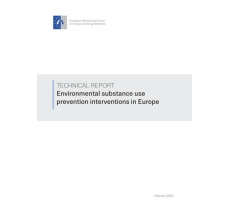Environmental substance use prevention interventions in Europe

EMCDDA. European Monitoring Centre for Drugs and Drug Addiction
EMCDDA releases report on European environmental prevention measures to limit unhealthy and risky substance use behaviours
There is a growing recognition of the important role environmental factors play in health-related behaviour. Traditional substance use prevention approaches in Europe have predominantly focused on warning or informing about the risks of use or on skills-based interventions. In contrast, environmental prevention policies aim to limit unhealthy behaviours by changing the environment in ways which influence people’s substance use choices. In a new report published today — Environmental substance use prevention interventions in Europe — the EMCDDA offers a first operational definition of the concept and an initial overview of where and how such interventions are being used in the region. The definition identifies three categories of environmental prevention measures: regulatory, economic and physical.
Drawing on the expertise of leading specialists in the field, today’s report contributes to the debate on this emerging issue. Based on the results of a survey of European prevention practitioners in 2016, the publication paints a first picture of the types of environmental prevention interventions being used in the substance use field in Europe and the extent to which such measures are being implemented. Although the survey has limitations, the publication provides a useful starting point for future research and identifies gaps in provision.
Many behaviours we perform every day are automatic and are generally reactions to common and familiar stimuli. Therefore, environmental and social cues and automatic processes are important influences on behaviour. There is growing recognition of the potential public health benefits to be obtained from interventions that take advantage of such processes to change behaviour.
Environmental prevention policies and interventions build on current interest in these approaches and seek to provide a stimulus that evokes healthier decisions. This can occur through altering the design of the environment, or aspects of it, to influence choice (‘choice architecture’)(1). For example, physical changes may include bars providing glasses for alcohol that are taller and narrower, but with smaller volumes, tending to make people drink less. Similarly, changes to the economic environment, such as increasing the price of tobacco, may discourage smokers. Regulatory changes can include legislation to constrain undesirable behaviours, such as cannabis use in public places, under-age drinking or drinking and driving.
The web-based questionnaire at the heart of the publication generated responses from 117 subjects (from 27 countries) with knowledge of substance use environmental prevention measures. It contained questions on measures covering illicit drugs, alcohol and tobacco and enquired whether measures were available nationally or locally. Of the 49 measures presented to the professionals answering the survey, 39 concerned regulatory and economic environmental prevention measures and 10 referred to physical environmental measures. Regulatory and economic measures were identified as available more often than the physical environmental measures.
National-level availability of a variety of regulatory measures related to illicit drugs was reported on average by 83% of respondents. For regulatory or economic measures relating to alcohol and tobacco, an average of 52% and 60% of respondents respectively indicated national-level availability. Physical environmental prevention measures were less commonly reported at the national level: for drugs, alcohol, and tobacco combined they were only reported by 19% of respondents. However, local availability of these physical measures was higher, reported, on average, by 56% of respondents.
While environmental prevention approaches are currently less well-known than traditional forms of prevention, this may change. Globalisation and rapid technological change may increase substance use opportunities and pressures and environments may become riskier. In these circumstances, environmental interventions are likely to be needed, in addition to skills-based interventions, in order to sustain protective behaviour. Such interventions impact behaviour differently and create complementary ways of achieving positive socialisation.
La Comisión Europea está preparando una tercera fase de este programa, por lo que COPOLAD volverá a principios de 2021.

